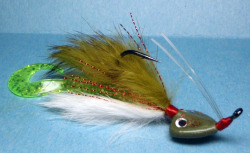|
Bucktail Jigs and Tied JigsBucktail Jigs have a rich history and an intriguing future. They've been a fishing lure staple for decades in both saltwater and freshwater. They are still being made today in as many colors, shapes, and sizes as you can think of.
The standard construction of bucktail jigs consists of one or more colors of bucktail tied to a weighted jig hook along with some flashy material. When more than one color is used, the darker color is almost always tied on top, just like the coloration of baitfish and other forage. And then flash is added just like you find on most hard baits and soft plastic lures.
If you're new to tied jigs or fly fishing, bucktail is just what it sounds like. It is the hair from the tail of a deer. Bucktail is relatively durable, inexpensive, moves pretty well in the water, and can be dyed to any color you can think of. The tying process is also pretty simple, and many tiers have cut their teeth on these simple jigs.
I even found a reference online stating that, “The bucktail jig was so effective that the US Army Air Corp included some fishing line and a bucktail jig in each pilot's survival kit in case he was shot down over the water.”
You'll find bucktails in most of the tackle shops in Texas, and they will mostly be heavily weighted jigs for fishing offshore. They are more commonly used as inshore lures in Florida and along the East Coast.
There hasn't been as much innovation in tied jigs in recent years, and their popularity has waned a bit. Although this may be changing as tackle companies take advantage of the many options for tied jigs as discussed below.
One such company that is exploring this new realm is Buggs Fishing. This company is near and dear to our hearts here at Saltwater Fishing Texas. We've been developing these fishing lures in tandem with our work on this site. The first Buggs lures were developed for use on the Texas Gulf Coast. You'll see the story soon on the Manufacturer's page. An example of one of the lures is shown above.
Tied Jigs have been catching fish for many years, for the reasons stated above. The Plugger references them in his book as teasers for his Spoons. These jigs work well for any fish that swims. While bucktail is an effective material for saltwater fishing lures, there is a lot of room for innovation in this category.
Return from Bucktail Jigs to the Salwater Fishing Lures page. |
 The intriguing part of tied jigs is their versatility. Once a suitably weighted and designed jig hook is in place, the options are endless for what can be tied and created. In the hands of a skilled tier, the jig is a canvas, and the palette of materials is incredibly diverse. This means that the same materials and techniques that fly tyers use to create successful fly patterns can be applied to tied jigs. This opens up a whole new realm for lure fishermen.
The intriguing part of tied jigs is their versatility. Once a suitably weighted and designed jig hook is in place, the options are endless for what can be tied and created. In the hands of a skilled tier, the jig is a canvas, and the palette of materials is incredibly diverse. This means that the same materials and techniques that fly tyers use to create successful fly patterns can be applied to tied jigs. This opens up a whole new realm for lure fishermen.